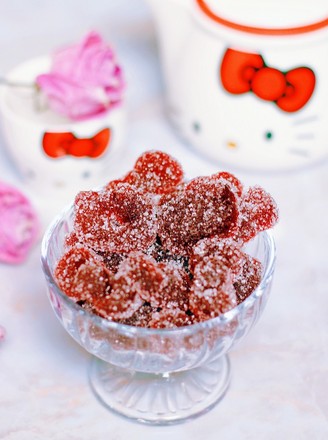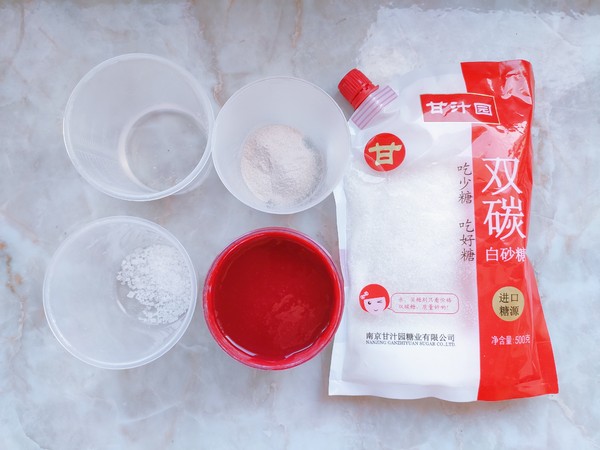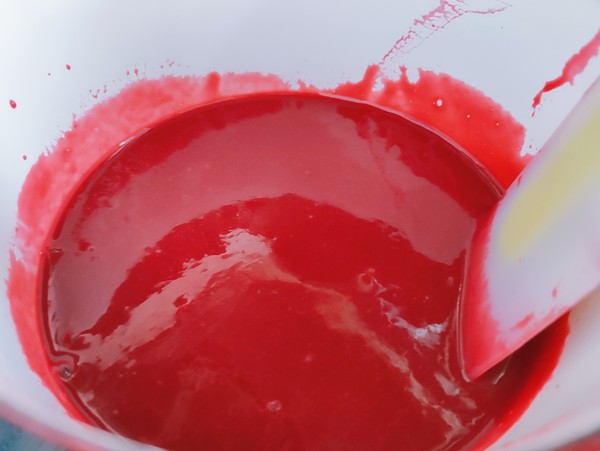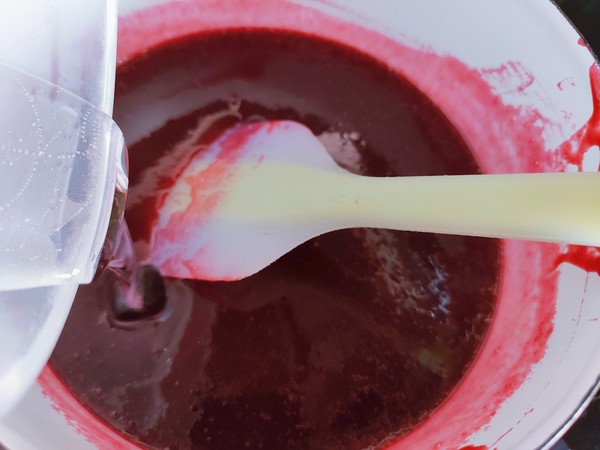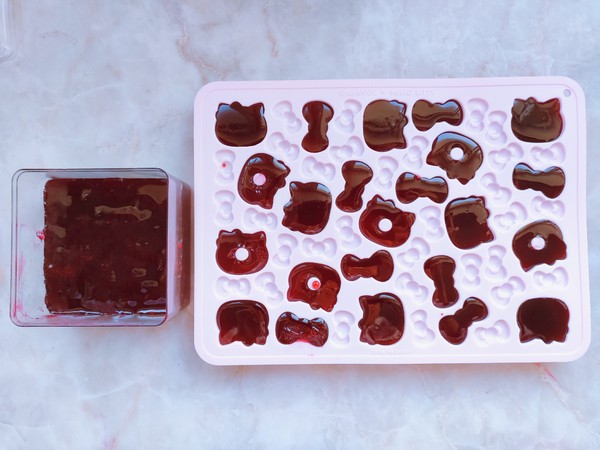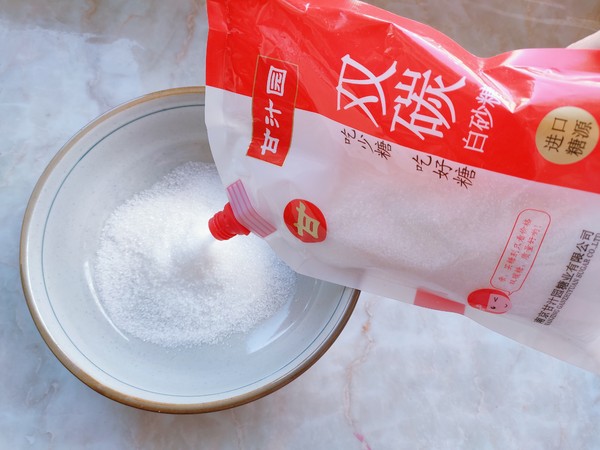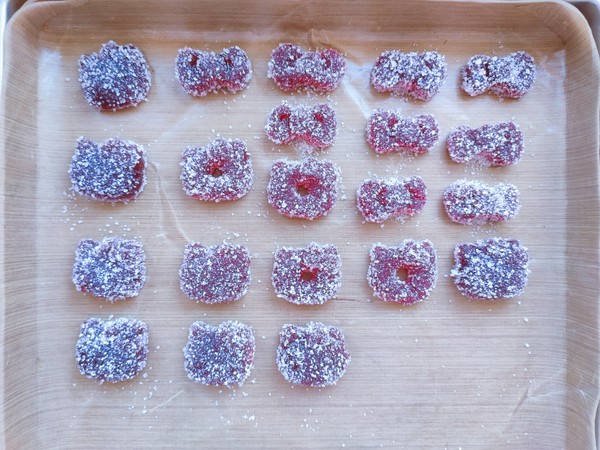Raspberry Fruit Jelly
by Looking for Peach Blossom Island
Favorite
Difficulty
Easy
Time
30m
Serving
2
In a blink of an eye, the end of the year, there are still more than 60 days to celebrate the Spring Festival. At this time of the year, whether it is a dessert shop, a private baking, or a housewife, you have to start making some sweets and snacks, whether they are packaged or given away, or you can keep them for your own food, to ask for a sweet good fortune during the New Year.
Take the gummy bears that my kids love to eat. In fact, you can make them yourself at home. You just need a small pot, boil it, stir it, pour it into a mold, cut into pieces and stick with powdered sugar. Homemade fruit jelly uses natural fruits, real materials, not fruity flavors, and it is safer to eat.
Next, take the production steps of raspberry jelly as an example to introduce the specific methods and operating points. At the end of the article, the recipes for orange gummies, mango gummies, passion fruit gummies, and pineapple gummies are attached. The production steps are the same.
Kitchenware and tools used: boiling pot, heat-resistant silicone spatula, kitchen electronic scale, probe thermometer, induction cooker or electric ceramic stove (temperature control).
Mold: Xuechu HELLOKITTY chocolate silicone mold (or metal mousse ring, glass box can be used).
Ingredients: 250 grams of raspberry puree, 250 grams of caster sugar, 50 grams of glucose syrup, 7 grams of pectin, 4 grams of citric acid, 4 grams of water. (This recipe comes from PH French dessert master ANDY)
Before making it, prepare the ingredients, analyze the ingredients and explain the temperature control:
1. Fruit puree:
(1) Fruit puree is a fine fibrous fruit puree with fruit particles, which is generally stored frozen. You can use puree or puree in this recipe, but don't use jam or juice. Different types of fruit purees have different properties, and the proportions of added pectin and sugar are also different. Please do not change the formula at will. Fruit puree can be bought in more professional bakery material stores, and common brands such as Baorong and Scrooge are also available. It is possible to peel and core the leftover fruits at home, and use a food processor to puree them directly (without adding water).
(2) The raspberry in this recipe is a sweet and sour raspberry, which can be replaced with strawberry, blueberry, or gooseberry. Strawberries will be available in large quantities after December, and they are just right for making soft sweets. If you like other fudges, please find the corresponding recipe at the end of the article.
2. Glucose syrup: The function is to maintain the elasticity and softness of the soft candy, which can be replaced by corn syrup or honey.
3. Pectin: plays the role of coagulation and fixation. NH apple pectin is used here, but other types such as FX58 can also be used. Please note: the pectin here is not mirror pectin for glazing. The mirror pectin cannot be solidified after heating, and it is not suitable for making soft candies.
4. Citric acid: It is a food additive that is allowed to be added to jams, beverages, cans and candies, and it is also widely present in nature. Adding citric acid to candies can harmonize the sweet and sour fruit flavor, promote pectin coagulation, and extend the shelf life of candies. You can buy them in general bakery stores. If you can’t find them, you can use a little lemon juice instead.
temperature control:
The boiling temperature in this formula should be controlled at 107°C. Different types of fruit jelly require different temperatures. For example, apricots and strawberries are all 107°C, but pineapple and orange jelly are 106°C, and mango is 105°C. Adjust arbitrarily, otherwise it will affect the effect of the finished product.
Take the gummy bears that my kids love to eat. In fact, you can make them yourself at home. You just need a small pot, boil it, stir it, pour it into a mold, cut into pieces and stick with powdered sugar. Homemade fruit jelly uses natural fruits, real materials, not fruity flavors, and it is safer to eat.
Next, take the production steps of raspberry jelly as an example to introduce the specific methods and operating points. At the end of the article, the recipes for orange gummies, mango gummies, passion fruit gummies, and pineapple gummies are attached. The production steps are the same.
Kitchenware and tools used: boiling pot, heat-resistant silicone spatula, kitchen electronic scale, probe thermometer, induction cooker or electric ceramic stove (temperature control).
Mold: Xuechu HELLOKITTY chocolate silicone mold (or metal mousse ring, glass box can be used).
Ingredients: 250 grams of raspberry puree, 250 grams of caster sugar, 50 grams of glucose syrup, 7 grams of pectin, 4 grams of citric acid, 4 grams of water. (This recipe comes from PH French dessert master ANDY)
Before making it, prepare the ingredients, analyze the ingredients and explain the temperature control:
1. Fruit puree:
(1) Fruit puree is a fine fibrous fruit puree with fruit particles, which is generally stored frozen. You can use puree or puree in this recipe, but don't use jam or juice. Different types of fruit purees have different properties, and the proportions of added pectin and sugar are also different. Please do not change the formula at will. Fruit puree can be bought in more professional bakery material stores, and common brands such as Baorong and Scrooge are also available. It is possible to peel and core the leftover fruits at home, and use a food processor to puree them directly (without adding water).
(2) The raspberry in this recipe is a sweet and sour raspberry, which can be replaced with strawberry, blueberry, or gooseberry. Strawberries will be available in large quantities after December, and they are just right for making soft sweets. If you like other fudges, please find the corresponding recipe at the end of the article.
2. Glucose syrup: The function is to maintain the elasticity and softness of the soft candy, which can be replaced by corn syrup or honey.
3. Pectin: plays the role of coagulation and fixation. NH apple pectin is used here, but other types such as FX58 can also be used. Please note: the pectin here is not mirror pectin for glazing. The mirror pectin cannot be solidified after heating, and it is not suitable for making soft candies.
4. Citric acid: It is a food additive that is allowed to be added to jams, beverages, cans and candies, and it is also widely present in nature. Adding citric acid to candies can harmonize the sweet and sour fruit flavor, promote pectin coagulation, and extend the shelf life of candies. You can buy them in general bakery stores. If you can’t find them, you can use a little lemon juice instead.
temperature control:
The boiling temperature in this formula should be controlled at 107°C. Different types of fruit jelly require different temperatures. For example, apricots and strawberries are all 107°C, but pineapple and orange jelly are 106°C, and mango is 105°C. Adjust arbitrarily, otherwise it will affect the effect of the finished product.

